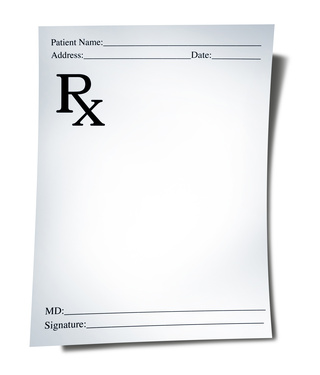What is a Prescription?
This page answers the question, "What is a Prescription?"
A prescription (℞) is a written order by a physician or medical doctor to a pharmacist in the form of medication instructions for an individual patient.
It can also be defined as an order to take certain medications.
A prescription has legal implications; this means the prescriber must assume his responsibility for the clinical care of the patient.
Recently, the term “prescription” has known a wider usage being used for clinical assessments, laboratory tests or imaging studies.
What Are The Main Things
On An Rx?

- Name of medical practice or physician,
- physical address of medical practice or physician (if multiple doctors are listed on a prescription, usually the doctor will circle his or her name for clarification),
- phone number of the medical practice/physician,
- name of the patient,
- the date the prescription was written
- All prescriptions, except for class II-V drugs, expire one year after they were written.
- Class II-V drugs expire 6 months after they were written.
- medication name,
- medication strength,
- sig (or directions to the patient, usually written in medical language or abbreviated medically),
- number of refills, if any,
- “PRN” refills means as many refills as that patient needs for 1 year
- Class II medications never have refills-a new prescription must be brought to the pharmacy each time the patient needs that medication
- Class III-V medications are only allowed 5 refills(the original fill plus 5 refills)
- a DAW Code (or dispense as written code)
- The most common DAW code is DAW 0, which means that the generic drug was substituted for the brand name drug.
- DAW 1 means that the prescriber mandates that only the BRAND name medication be given to the patient.
- A DAW 2 means that the BRAND name medication is filled at the patients request.
- a prescriber’s signature (a prescription is incomplete without this important part of the prescription.)
- the prescribers DEA Number and/or their NPI Number.
Prescriptions and Prescriber's Handwriting
Unfortunately many handwritten prescriptions are illegible. It is believed that illegible prescriptions kill more than 7,000 patients every year.
Physicians use many abbreviations derived from Latin phrases and these must be understood correctly by the pharmacist.
However, abbreviations should be used cautiously because many of them carry an increased risk for confusion.
There are also established conventions for prescription-writing, in order to avoid any misinterpretation. Some of these conventions are:
- prescriptions must be written with permanent ink;
- decimal points must be used carefully to avoid ambiguity;
- units as “teaspoons” or “tablespoons” should be avoided;
- the degree symbol (°) should not be used for hours (e.g., "q 1-3°" for every 1 – 3 hours), because it can be confused with a zero;
- usage directions should clearly specify times (7 am, 7 pm) rather than frequency (two times a day);
- directions should be written in full in English (even if some Latin abbreviations are still being used);
- numbers should be written as words and numerals (e.g., ("dispense #20 (twenty)");
- apothecary/avoirdupois units and symbols of measure must be avoided; metric units should be always used;
- in case of refills, the minimum time between repeats and also the exact number of repeats should be clearly specified.
In case of an illegible handwritten prescription, the pharmacist or technician must contact the physician who wrote it for clarifications.
Another reason the pharmacist may want to contact the physician is in the case of suspected Forgery.
Page Mini-Summary
This page, "What is a Prescription?" discusses what a prescription is, the main things on a prescription, prescriber's handwriting, suspected forgeries, and more.






New! Comments
Have your say about what you just read! Leave me a comment in the box below.